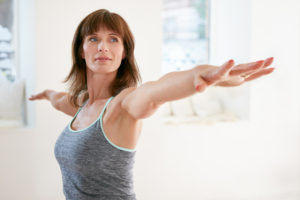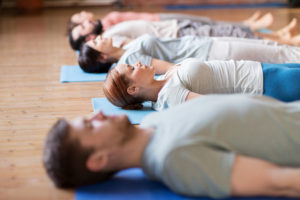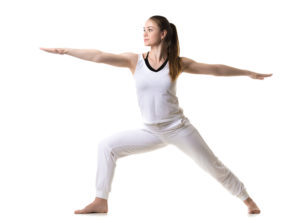Yoga for Beginners: How It Benefits Your Body, Mind, and Spirit
What is yoga? Our contributing writer—a longtime yoga instructor—offers a helpful primer in explaining how and why to get started in this highly beneficial exercise.
Originating in India, yoga has been around for more than 5,000 years. It’s a practice that strengthens and stretches the body while also using our breath to focus and calm the mind. Everyone—especially older adults—can enjoy the multiple physical, mental, and spiritual benefits of yoga. For beginners and veterans alike, it’s a wonderful exercise on its own and a complement to other sports and physical activities.
Yoga for Beginners: It Starts with the Breath
Breathing exercises, a common opening practice in many yoga classes, help to increase circulation throughout the body. The breath work can reduce stress, serving to positively influence the immune and cardiovascular systems.
There are many techniques for yogic breathing, called pranayama. For example, “breath of fire” is meant to invigorate the body with short, quick rhythmic breathing, requiring core muscle control. Pranayama can also be as simple as slowly inhaling and slowly exhaling. Doing that for just a few minutes can quickly calm the mind and the body.

You may experience a subtle “pulling” sensation when holding a yoga pose, author JoAnn Milivojevic notes, “but nothing should ever hurt.”
Yoga Postures to the Stretch and Strengthen
With age, muscles, tendons, ligaments, and connective tissue (called fascia) can become less flexible. Some inflexibility is due to changes in collagen fibers. But, stiffness is also due to lack of activity. Yoga poses—also called postures or, in Sanskrit, asanas—are practiced to increase flexibility, strength, and balance.
Postures should be held for at least 20 seconds to elongate muscle fibers. Focusing on the breath helps practitioners become more aware of how the body feels from the inside. This is particularly important when it comes to stretching because over-stretching can lead to injury.
There could be a mild sensation of pulling when holding the pose, but nothing should ever hurt. If you feel a sharp stabbing pain, or joint discomfort, you’re stretching too far.
Yoga for Beginners: Finding an Appropriate Class
Yoga comes in many styles. Hot yoga is done in a room heated to about 100 degrees. The heat can help muscles relax and elongate. It’s best to do this style of yoga in a room that is warmed with moist heat and well-ventilated. Floors should be wood or made of an antibacterial material, rather than carpeting.
The style that ignited hot yoga is called Bikram. This style, which started in the 1970s, is very vigorous, and modifications are uncommon. The concept of doing yoga in a hot room has since expanded to other styles.
Use caution and common sense regarding classes held in heated rooms, as they may not be appropriate for those with certain health conditions or taking some medications. Similarly, power yoga, flow classes, and Ashtanga are demanding styles and designed for more seasoned practitioners.
Getting Started with Yoga
So what are the best choices when it comes to yoga for beginners? Consider classes whose descriptions include words like gentle, senior, chair yoga, yin, restorative, hatha, or Iyengar. These classes are generally milder and focus less on more on stretching vs. intense strengthening positions. Examples of such stretching positions:
- Full back bends
- Head stands
- Arm balances
Milder classes often include props like straps, blocks, blankets, and bolsters that help students properly position their bodies.
Proper alignment along with modifications are crucial to avoid injuries. The ability to offer modifications for a variety of students’ needs is what separates a well-trained, highly experienced instructor from a novice. Look for instructors who have completed at least 200 hours of training and who have been teaching for a few years.
What to Expect in a Yoga Class
While there is generally no set routine, most classes will focus on stretching the entire body—arms, legs, hips, torso, shoulders, neck, and back. Be sure to let your yoga teacher know about any medical issues you have and ask about the physical demands of the class. It is common for students to simply skip a posture that isn’t right for their bodies.
Yoga props (blocks, blankets, straps, bolsters, and mats) are usually available in classes. Yoga mats—also called sticky mats—provide a non-skid surface so that your hands and feet don’t slip. They also provide some cushioning. While it can be intimidating to sit in the front of the class, it’s a good spot to see instructors as they demonstrate the postures. Also, many instructors will offer verbal and sometimes hands-on corrections to help you get into proper alignment.

The Savasana (or “Corpse”) pose is an important way to close a yoga session, yet some people skip out on it. Experts advise practitioners to stay and finish to get the benefits of Savasana.
Final Relaxation
The classic ending posture in most yoga class is called the corpse pose (Savasana in Sanskrit). As the name implies, it is a relaxed position on your back. This important final resting pose should not be missed (though some students use this time to leave the class). It is an opportunity to fully practice relaxing and allowing your body to absorb the benefits of the exercise.
Guided meditations and body scans (mentally and systematically exploring one body part at a time) are worthy tools for use outside of class. The ability to release tension at will leads to less stress, improved sleep, and better overall health.
For further reading, please visit these posts:
- Yoga Is Powerful Chronic Fatigue Treatment, Studies Show
- 20-Minute Seated Yoga Is a Successful Chronic Fatigue Syndrome Treatment
- 3 Surprising Immune System Boosters: Meditation, Mindfulness, and Yoga
- Yoga for Concentration, Cognition, and Memory: Studies Show It Works
- Yoga Found Effective for Pregnancy Anxiety
Author JoAnn Milivojevic, editor of UCLA Health’s Healthy Years, is a longtime yoga and Pilates practitioner and certified instructor.



 Exercises For Mobility
Exercises For Mobility  Living with Dementia Means Having a Greater Fall Risk
Living with Dementia Means Having a Greater Fall Risk  Is Walking Good Exercise?
Is Walking Good Exercise? 
Yoga for beginners or for longtime practitioners typically starts with breathing exercises.
© Tatyana Mukhomedianova | Dreamstime